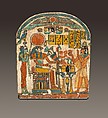Stela of Saiah
Third Intermediate Period
This is one of four stelae found near the doorway of the brick chapel of the family of Saiah, a wab, or purification priest of Amun who lived during the latter half of the 22nd Dynasty. The original tomb in whose courtyard this chapel was built dates to the 11th Dynasty, over a millennium earlier. All of the stelae are made of wood, painted in green, red, yellow and black on a white gesso ground.
Inscribed for Saiah himself, this stela is painted on both sides. On the front, the deceased, to viewer right, presents a heart-shaped object to a figure of the falcon-headed god Re-Harakhty-Atum, who sits on a cubic throne atop a reed mat. Before the god is a table piled high with offerings, and standing behind him is the goddess of the West, Imentet. In the lunette of the stela is a winged sun disk, two wedjat eyes (eyes of Horus), and two shen rings, symbols of eternity. The inscription above the offering table asks that Re-Harakhty-Atum, lord of the Two Lands and of Iunu (Heliopolis) give offerings. Above Saiah's head is written, "the Osiris, the purification priest of Amun who has no fault, Siah, son of Djed-Bastetankh."
On the back are two registers. In the bottom register, the goddess of the sycomore stands and pours water into the outstretched hand of a male figure seated to viewer right, most likely Saiah himself; a second identical male figure sits to the left, but there is a loss in the area between the goddess and the human, with only a bit of a libation vessel preserved. Above is the sun bark, held up by a kneeling god flanked by two kneeling goddess, presumably Isis and her sister Nephthys. Standing figures of Saiah with his arms raised in prayer frame the upper register; before the figure to the left is inscribed, "Worship by the purification priest of Amun, Saiah."
Due to rights restrictions, this image cannot be enlarged, viewed at full screen, or downloaded.
This artwork is meant to be viewed from right to left. Scroll left to view more.



